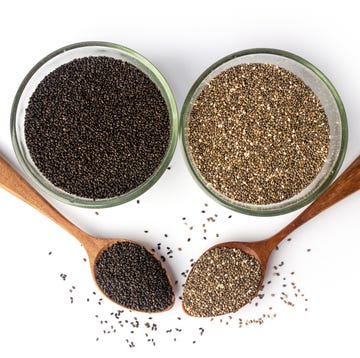The holidays tend to be a time of overindulgence — imbibing in more alcoholic beverages than you may typically do. It’s why many people decide to “dry out” in January with a month-long sobriety challenge: refraining from drinking alcohol for the full 31 days.
If you’re someone who likes to unwind in the evening with a glass of wine or meeting friends for drinks is one of the primary ways you socialize, committing to a month of not drinking any alcohol whatsoever may seem unrealistic to you (even though there are so many benefits to it). Here’s the good news: It doesn’t have to be all or nothing. Participating in what people are calling "Damp January" — cutting back on how much alcohol you drink without giving it up completely — can also benefit both the mind and body in several important ways.
What Is Damp January?
“Damp January is a way for you to bring mindfulness to your alcohol consumption. It’s not ‘wet,’ where there’s no awareness or change, and it’s not ‘dry,’ where alcohol is completely off-limits. Instead, it’s ‘damp,’ encouraging a gentler approach,” says Rebecca Russell, RD, IFNCP, a functional medicine registered dietitian at The Social Nutritionist. She explains that the goal of Damp January is to drink less while removing the all-or-nothing mindset. This, she says, makes it more sustainable and approachable.
Registered dietitian Kim Shapira, RD, says that the goal of Damp January is also to re-evaluate your relationship with alcohol. “Rather than a strict abstinence, Damp January allows for a mindful approach, where you get to choose to have a drink or not based on how you feel in the moment you are in,” she says.
Both dietitians say that anyone who wants to develop a more mindful relationship with alcohol can benefit from Damp January. “It allows you to reflect on your reasons to drink alcohol and then make intentional decisions about consumption. Essentially by not subscribing to a ‘rule’ about alcohol consumption you are able to make a more conscious decision. By focusing on moderation instead of strict rules, you can create a more sustainable approach to alcohol intake not just in January, but also yearlong,” Russell says.
For example, maybe having a glass of wine with dinner or after dinner is so ingrained into your evening routine that you do reach for a wine bottle without even thinking about it. Damp January is an opportunity to think more consciously about alcohol consumption instead of just pouring that glass without even thinking about it.
What are the health benefits of Damp January?
Family medicine physician Laura Purdy, MD, emphasizes that drinking alcohol — even in moderation — isn’t beneficial in any way. That, within itself, is proof that you can benefit from just cutting back instead of giving it up completely.
“Drinking alcohol increases your risk of a range of health concerns. The more you consume and the more often you drink impact your risk level, so taking a break and consuming less can lower your risk,” Dr. Purdy says. In other words, while you will get the maximum health benefits from giving up alcohol completely, reducing the amount you drink lowers the risk of various health concerns. Below are six ways you can benefit from Damp January.
Tips for making Damp January a reality
Think you want to give it a go? Dr. Volpicelli says it can be helpful to set specific, realistic goals. “Decide what moderation means for you. For example, you might aim to limit drinking to a certain number of drinks per week or only drink on weekends. Clear goals help you stay accountable and avoid vague resolutions,” he says.
Dr. Volpicelli says that it can also be helpful to think about what situations make you want to drink alcohol and plan in advance how you’ll handle them. For example, if you like having an alcoholic drink to unwind at the end of the day, stock up on zero-proof versions of what you like to drink, such as non-alcoholic beer, alcohol-removed wine or zero-proof cocktails.
Instead of going into social situations vowing not to drink, Shapira recommends committing to a “maybe.” “Being mindful means knowing where your mind is without judgment. If your mind suggests a drink is a good idea, you can respond with, ‘Thanks mind, I will see how I feel,’” she says. She adds that you can also start with a non-alcoholic drink and then decide after you finish it if you want to switch to an alcoholic one or not.
If you do decide to drink, Shapira says to sip it slowly and savor it. “Being mindful means staying in the moment you are in. If you are having a drink — or even if you are drinking a non-alcoholic beverage — sip it slowly. Avoid distractions. Take deep breaths before you order. These tips will help you stay present,” she says.
As the month progresses, Dr. Volpicelli recommends regularly checking in with yourself and reflecting on how you're feeling physically, mentally and emotionally. “If your goals feel too rigid or too loose, adjust them as needed to stay successful. Use this opportunity to understand your relationship with alcohol better and make informed choices beyond January,” he says.
At the end of the month, you may decide to keep your Damp mindset going. Even if you don’t, it’s always something you can come back to. After all, re-evaluating your relationship with alcohol is something you can benefit from any time, not just in January.
The bottom line
Damp January is less hardcore than Dry January, but that certainly doesn't mean it isn't beneficial. Cutting back on alcohol consumption without giving it up completely benefits both mental and physical health. It's also an opportunity to re-evaluate your relationship with alcohol, which can lead to healthier drinking habits long-term.












